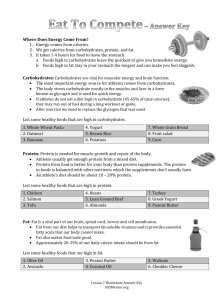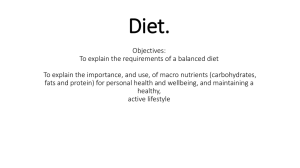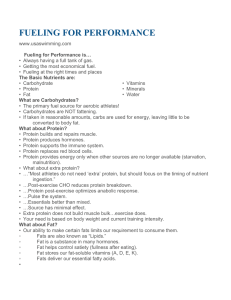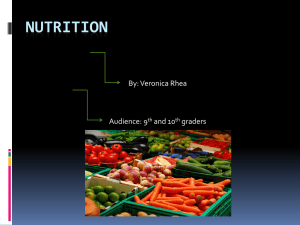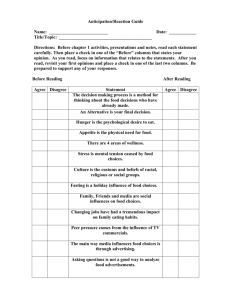Sports Nutrition
advertisement
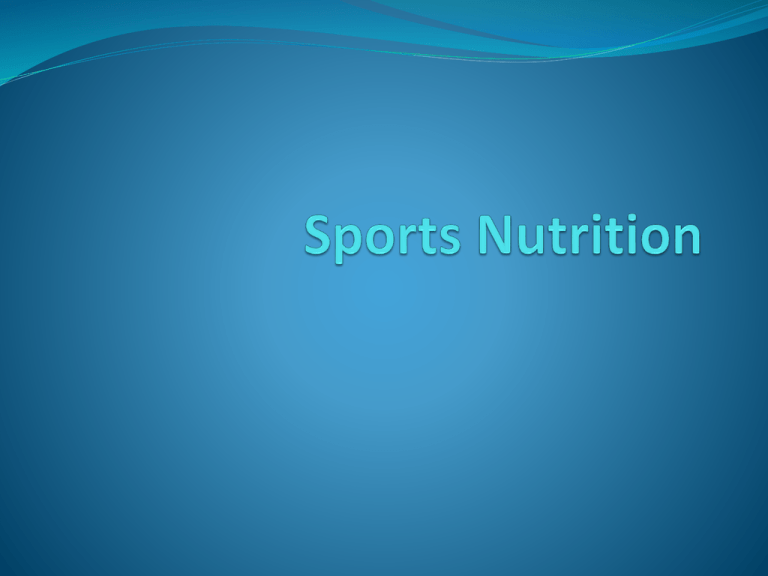
Performance Influencing Factors Genetics Training and Conditioning Nutrition Performance Nutrition Means… Fueling to boost activity performance on a daily basis Fueling to decrease the risk of injuries, recover fully after workouts and stay healthy Fueling with foods that taste good, foods you enjoy, foods that can be prepared easily, and foods you feel confident eating Effects Of Good Nutrition Energy Endurance Growth Hydration Performance Prevention of diseases Repair Consequences of Poor Nutrition Weight loss Strength loss Lethargy Chronic Fatigue Soreness, joint pain Micronutrient Deficit Respiratory Infections Diminished Performance “Overtraining Syndrome” What food does for the body Food satisfies 3 basic needs for the body Supplies ________ Energy Calories A unit of heat Supports new tissue _______ and tissue ________ Growth and repair Helps to regulate __________ Metabolism Sum of all physical and chemical processes that take place in the body (conversion of food to energy) Healthy Diet What are the 5 food groups? Bread/rice/cereal pasta (carbs), veggies (vit & min), fruits (vit and min), meat (protein), dairy (protein and fat) Two principles to follow to create a healthy diet to improve performance… 1: Eat a_______ of foods Vary your foods and balance from the 5 food groups 2: Eat in _________ Don’t eat too much or too little of any nutrient/food group Nutrients Nutrients Substances that provide nourishment 6 classes of nutrients: Only 3 provide energy Carbohydrates Fat Protein Vitamins Minerals Water ____________ between nutrients is important to prevent any deficiencies or excess build up impair performance Carbohydrates A complex sugar that is a basic source of energy for the body 1 gm = 4 calories 60% of caloric intake Most readily available source of food energy Broke down to glucose for energy Glucose is stored in liver and muscle tissue as glycogen High carb diet is necessary to maintain muscle glycogen which is the primary fuel needed by athletes Carbohydrates (CHO) Fuel Muscle A muscle is like a sponge Keep muscles full of fuel Carbohydrates reach muscles quickly Substrate used to form Glycogen Glycogen is the PRIMARY energy source The Effect of Diet on Physical Endurance Maximum endurance time: Fat and protein diet 57 min Normal mixed diet 114 min High-carbohydrate diet 167 min Carbohydrates = FUEL Carbohydrate Needs: 30 minutes moderate exercise: 4-6 gm/kg (1.8-2.7 gm/#) 1 hour intense training/day: 7gm/kg (3gm/#) 1-2 hours intense training/day: 8-9 gm/kg (3.54gm/#) 2-4 hours intense training/day 9-10gm/kg (4-4.5 gm/#) Ultra endurance athlete: >12gm/kg (5.5gm/#) 150-lb student who does Aerobics classes: 165 Pound Soccer Player: 675 gm/day 300 gm/day Sample Athlete Male soccer player Training 2-3 hours/day 165 lbs = 75kg 9gm CHO/kg = 675 gm CHO What does 675gm of CHO mean to an athlete? 2 large bagels 2 cups cereal 2 slices bread 2 cups milk 1 cup fruit yogurt 2 cups pasta/sauce 1 cup beans 2 pc fruit 1 cup fruit juice 2 starchy veggies 4 cups Sport Drink 20oz Soda 70g 90g 30g 25g 45g 100g 45g 50g 30g 60g 60g 70g 675g Fiber Dietary Fiber Portion of plant foods that cannot be digested Soluble vs Insouble Soluble- help reduce blood cholesterol levels Insoluble- “intestinal cleaner”, help prevent constipation and other colon disorders Athletes should avoid eating fiber ~6 hours before training/event Protein A major structural component of all body tissue and is required for tissue growth and repair. 1 gm = 4 calories 10% of caloric intake should come from protein Primary building block of body, but provides little energy Composed of building blocks called ______ ______ Amino Acids Total of 20 Amino Acids ____ essential amino acids (must be provided by food) ____ are made in the body Proteins Complete Proteins Meat, fish and poultry that contain all 9 EAA Incomplete Proteins Do not contain all 9 EAA (vegetable proteins) Carbohydrates provide quick energy. Proteins, consumed days earlier, will increase stamina When picking protein in your diet, pick low-fat protein Tuna packed in water vs oil (1 g fat v 10 g fat) Fat (lipids) Most concentrated source of food energy 1 gm = 9 calories Burning 1 gram of fat requires twice the amount of exercise (energy) than burning 1 gram of carbs/protein Make up no more than 30% of caloric intake Fat insulates and protects the body’s organs and aid in absorption and transport of fat soluble vitamins Fat Categories Saturated Unsaturated Solid at room Liquid at room temperature Mainly found in animal sources Butter Lard temperature Found mainly in plants Safflower oil Olive oil Canola oil Fat intake should come from Unsaturated Fats Determinants of the Athlete’s Energy Requirements During intense exercise Carbohydrate stored in muscles and liver (glycogen) is predominant fuel source During prolonged exercise Fat stores are predominant fuel source Fitness level of the athlete Well trained endurance athletes burn fat more efficiently, sparing limited glycogen stores Vitamins Organic compounds that the body requires in small amounts for normal body function Regulate metabolism Help with processes in the body: Energy production Growth Maintenance Repair Total of 13 essential vitamins Divided into two groups: Water soluble (B and C) Fat soluble (A, D, E, K) Vitamins and Athletes Obtain vitamins from variety of foods Any excess vitamins from supplements are not utilized by the body and are excreted in the urine Vitamins: A, B complex (B1, B2, B3, B6, B12), C, D, E, K, Folic Acid, Pantothenic Acid, Biotin Main one that aids with energy? B complex Important for bone strength? Vitamin D Minerals Inorganic compounds that are essential to body function Two groups: Major Minerals- needed in large amounts Minor Minerals (Trace)- needed in small amounts Should get all minerals from a variety of foods Exception: Female athletes Calcium- extra to prevent osteoporosis Iron- help to improve oxygen throughout the body and boost energy Water Body is ~%70 water Keeps dehydration away which can impair athletic performance Controls body temp Energy production Elimination of body waste Needs in the body: Sedentary- 64 oz (8 glasses) Active- 3-4 quarts/day Drink ~1/2 your body weight in oz of H2O When does dehydration kick in? As soon as you feel thirsty Dietary Guidelines for Americans Eat a variety of food Balance food with exercise Plenty of grains, veggie and fruits Diet low in fat, sat. fat, cholesterol Moderate sugar intake Moderate sodium intake How many calories do you burn? Need two things to determine Basal Metabolic Rate (BMR) The rate at which the body normally burns calories Someone’s BMR depends on 3 things… Height Weight Age Activity Level Does your food intake meet your needs? Get out a calculator and complete the worksheet Pre-Exercise/Competition Meal Eating a proper meal the day of event will _____________ and __________ Prevent hunger during exercise/competition Maintain adequate blood sugar levels Low blood sugar levels will affect concentration, coordination and timing Diet several days before competition affects amount of glycogen in muscles Exercising/competing on a full stomach, good or bad? Causes indigestion, nausea and possible vomiting Pre-Exercise/Competition Meal How long before an event should an athlete eat? One hour Takes ~ 1 hour for nutrients to reach the body What makes up a good pre-event meal Small bowl of cereal with 1% milk and juice or fruit 2T peanut butter on whole wheat bread, juice/fruit Granola bar and apple No supply of food? Keep a supply of liquid or nutrition bars Fuel For Your Workout My Workout is in <Hour = Fruit Low Intensity My Workout is in >Hour = Carbs, Protein & Fruit Less Than 60 Minutes < Hour = Small snack w/ simple carbs (Whit toast w/ jelly, gatorade) High Intensity > Hour = Complex Carbs (Whole wheat bread w/ PB) How Long Do I Plan To Exercise? < Hour = Complex c Carbs and Protein Low Intensity (Whole wheat crackers and string cheese) > Hour = Complex Carbs, Fat and Protein (Whole grain cereal w/ skim milk, fruit and egg) More Than 60 Minutes < Hour = Simple Carbs (Dry cereal w/ raisins) High Intensity > Hour = Complex Carbs, Fat and Protein (Whole wheat bread w/ PB or Turkey Sandwich) Pre-Exercise/Competition Meal Foods to avoid before exercise/competition High fat and high protein foods Eggs, bacon, hamburgers and fried foods Go for high carbohydrate foods Quickly digested What to do for energy during endurance events Sports bars Bananas Sports drinks A LOT of water! Recovery Meal Need carbohydrates to replace lost glycogen in the muscles Muscles are able to store more glycogen immediately after exercise than any other time You can store 2x as much glycogen post workout than 2-3 hours later No hungry after workout? Sports drinks, sports bars Eating Disorders Most common? Annorexia Nerovsa Bulimia Death rate for long term athlete abusers 20-30% As a trainer, you need to watch for signs/symptoms in athletes You need to be aware of sports that have weight classifications! Wrestling, gymnastics, dancing, cross country and swimming Bulimia Characterized by binging on large amounts of food, followed by purging (vomiting), fasting, over-exercising or laxative abuse. Athlete is normally within normal weight Abnormal obsession about body size and a fear of fat Physical effects Sore throats (erosion of esophagus) Dental problems (tooth enamel destruction) Dehydration (loss of potassium can lead to cardiac problems) TX Monitored eating and evaluation by trained therapist Anorexia Nervosa Characterized by severe loss of appetite (problem with this definition?) Nervosa indicates this loss is related to emotional reasons Under weight (15% or more less than recommended weight) TX Monitored eating Evaluation Hospitalization and IV feeding Signs/symptoms Weighing several times/day Paranoid about gaining weight, intense fear Distorted body image Preoccupied with food and obsessed about calories Excessively thin Hypothermic Amenorrhea Cardiac arrhythmias Eating Disorders and Athletes Top 20 Famous Athletes With Eating Disorders.docx Sports Nutritional Myths Athlete’s bodies require supplements during training False-Supplements are only required when the diet is not able to meet the body’s demands Protein build strong bodies False-Exercise builds strong bodies. Protein is required to repair tissue but does not build muscle by itself Sports Nutritional Myths When we need fluids, we feel thirsty False- We need water long before we feel thirsty. Constant fluid replacement is required. Body weight matters most; light athletes are faster False- Body composition is more important than body weight. Muscle is heavy. Sports Nutritional Myths The only food intake that really matters is the food ingested immediately before an important event False-Nutrition is a long-term pursuit and what you eat weeks before an event can effect your performance What you eat between and after events doesn’t matter False-What you eat before, during, and after an event can affect your performance. Post event is very important for rapid recovery

